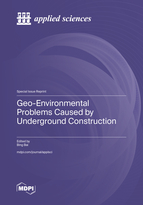Geo-Environmental Problems Caused by Underground Construction
A special issue of Applied Sciences (ISSN 2076-3417). This special issue belongs to the section "Environmental Sciences".
Deadline for manuscript submissions: closed (20 May 2023) | Viewed by 14289
Special Issue Editor
Interests: soft soil foundation treatment; geo-environmental engineering; engineering construction in special soil; energy underground structure construction; disposal and construction of contaminated sites; thermo-hydro-mechnical processes
Special Issues, Collections and Topics in MDPI journals
Special Issue Information
Dear Colleagues,
Geo-environmental disturbance refers to significant changes in the physical, mechanical and chemical properties of soils that are closely related to interrelated multi-physical field coupling systems of solid particles, water and gas in the shallow stratum, which are caused by underground engineering construction. In fact, the evaluation of possible geo-environmental hazards is an important topic worthy of the attention of researchers and engineers working in the construction of large-scale underground engineering. This is related to the suitability of civil engineering construction, especially for some complicated geological conditions such as saturated super-soft soil, laterite, loess, sand gravel stratum, saline soil, frozen soil, and karst stratum with rich water.
In recent years, an increasing number of geo-environmental problems have attracted many scholars and engineers, promoting the development of geotechnical engineering and its close intersection with other disciplines. These concerns include the settlement of ground surfaces, the collapse of underground supporting structures, landslides of soil slope, debris flows, the protrusion and blockage of tunnels, etc. For this purpose, it is necessary to investigate the micro-structures, physico-mechanical properties, deformation and strength evolution, and seepage characteristics of various geotechnical media.
This Special Issue titled Geo-Environmental Problems Caused by Underground Construction will address the most recent developments in the interaction between coupled multi-physical fields and underground structures, as well as geo-environmental effects, to stimulate fruitful technical and scientific interaction between professionals.
Potential topics include, but are not limited to, the following:
- Disturbance effect of underground construction;
- Geo-environmental problems in special soils;
- Landslides under long-term ground water action;
- Risk assessment and decision in underground construction;
- Coupled thermo-hydro-mechanical constitutive models;
- Environmental influence of energy pile construction;
- Seepage and prevention under multi-field coupling;
- Environmental effect of geothermal utilization;
- Geo-environmental geotechnics.
Prof. Dr. Bing Bai
Guest Editor
Manuscript Submission Information
Manuscripts should be submitted online at www.mdpi.com by registering and logging in to this website. Once you are registered, click here to go to the submission form. Manuscripts can be submitted until the deadline. All submissions that pass pre-check are peer-reviewed. Accepted papers will be published continuously in the journal (as soon as accepted) and will be listed together on the special issue website. Research articles, review articles as well as short communications are invited. For planned papers, a title and short abstract (about 100 words) can be sent to the Editorial Office for announcement on this website.
Submitted manuscripts should not have been published previously, nor be under consideration for publication elsewhere (except conference proceedings papers). All manuscripts are thoroughly refereed through a single-blind peer-review process. A guide for authors and other relevant information for submission of manuscripts is available on the Instructions for Authors page. Applied Sciences is an international peer-reviewed open access semimonthly journal published by MDPI.
Please visit the Instructions for Authors page before submitting a manuscript. The Article Processing Charge (APC) for publication in this open access journal is 2400 CHF (Swiss Francs). Submitted papers should be well formatted and use good English. Authors may use MDPI's English editing service prior to publication or during author revisions.
Keywords
- disturbance effect of underground construction
- geo-environmental problems in special soils
- landslides under long-term ground water action
- risk assessment and decision in underground construction
- coupled thermo-hydro-mechanical constitutive models
- environmental influence of energy pile construction
- seepage and prevention under multi-field coupling
- environmental effect of geothermal utilization
- geo-environmental geotechnics






